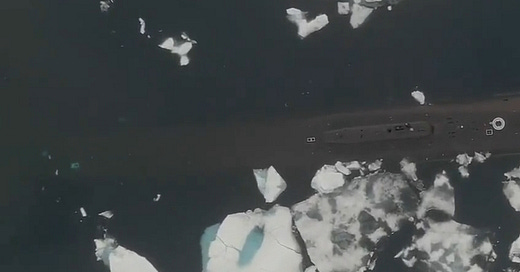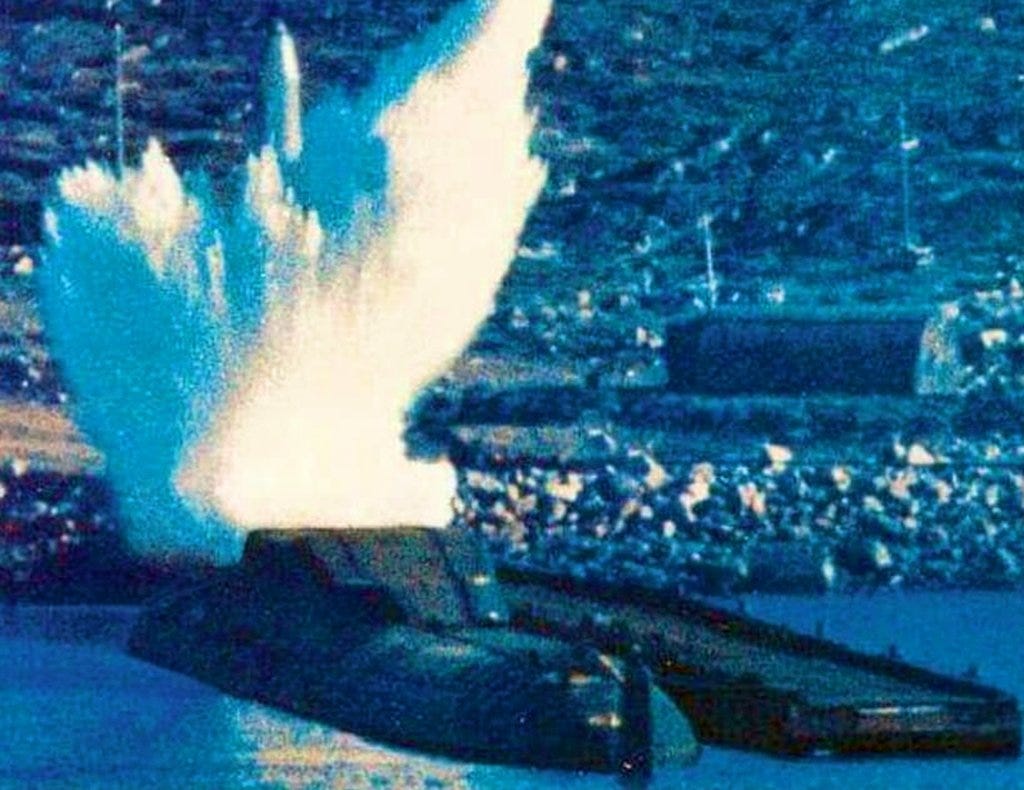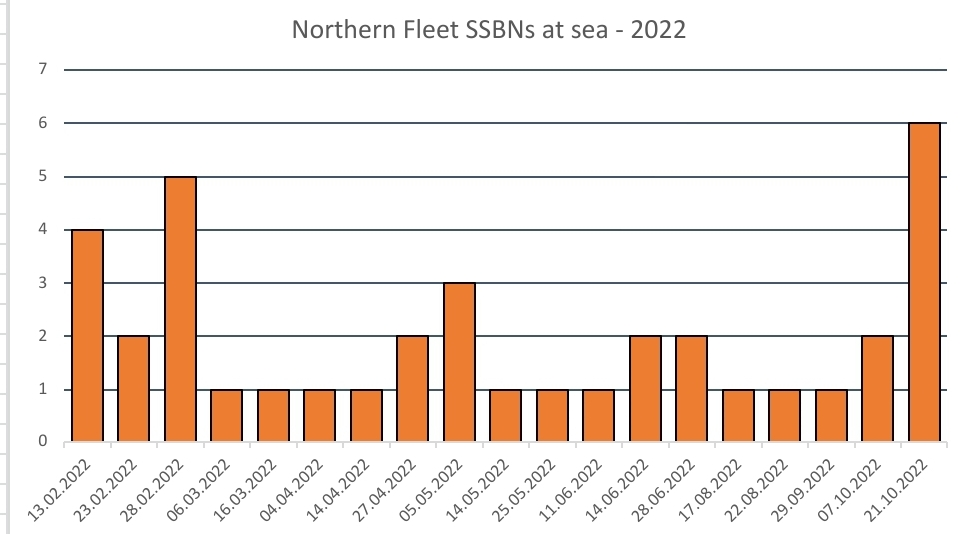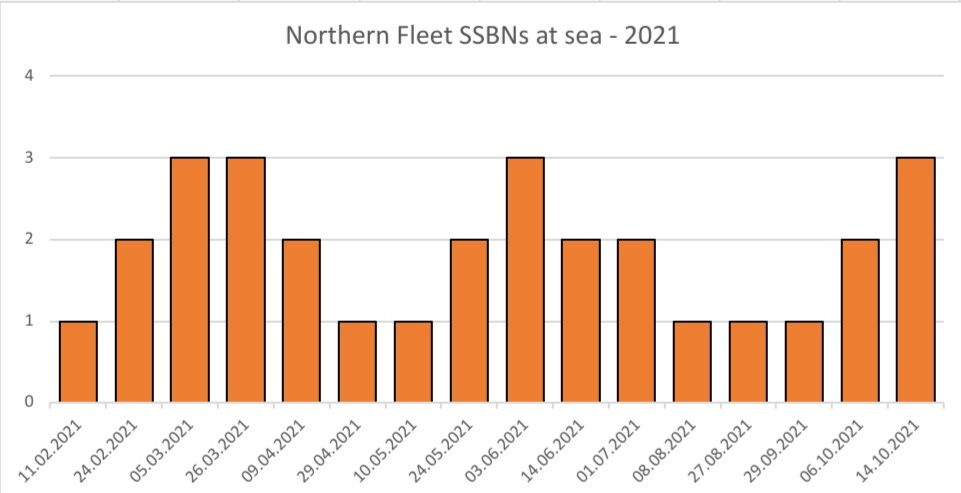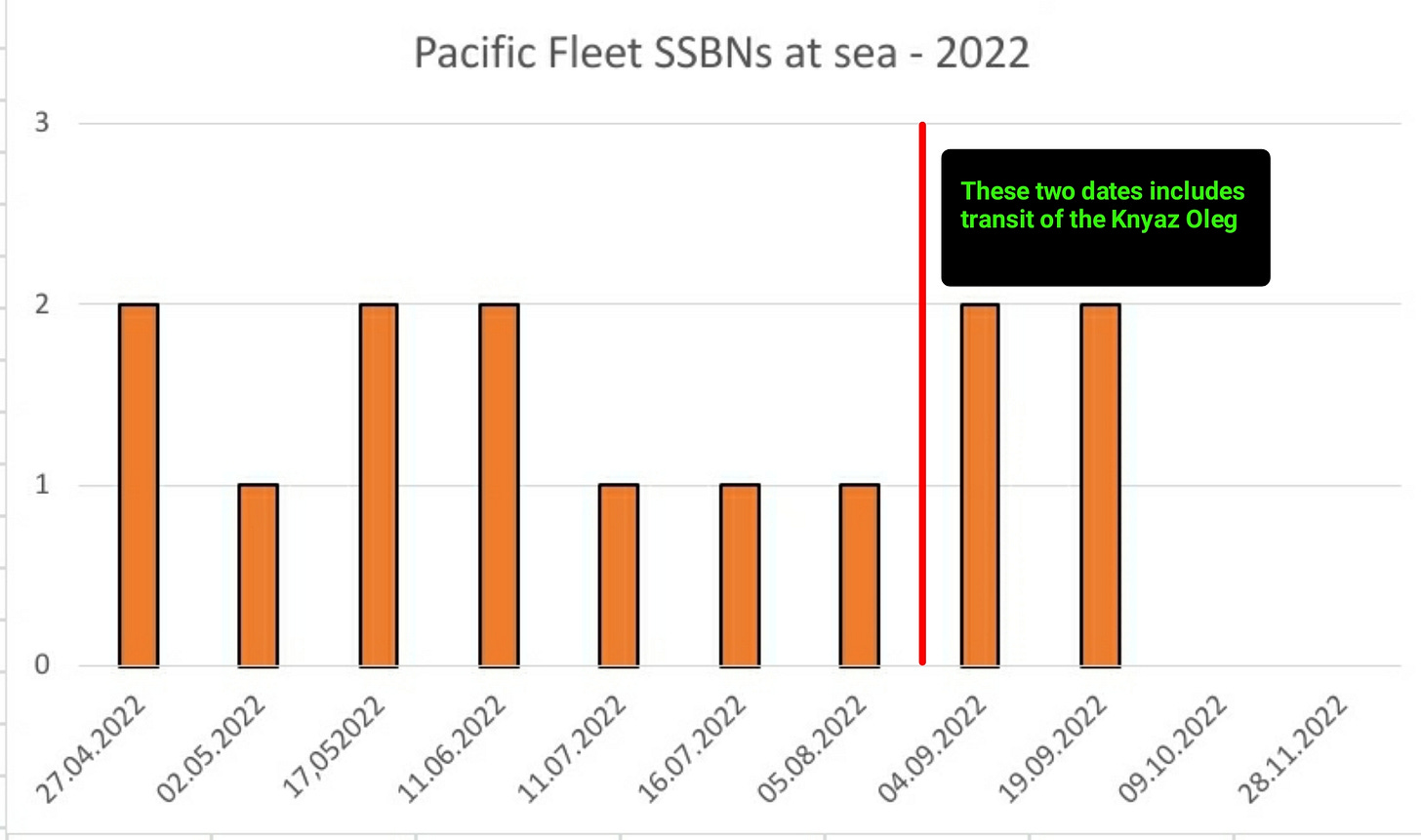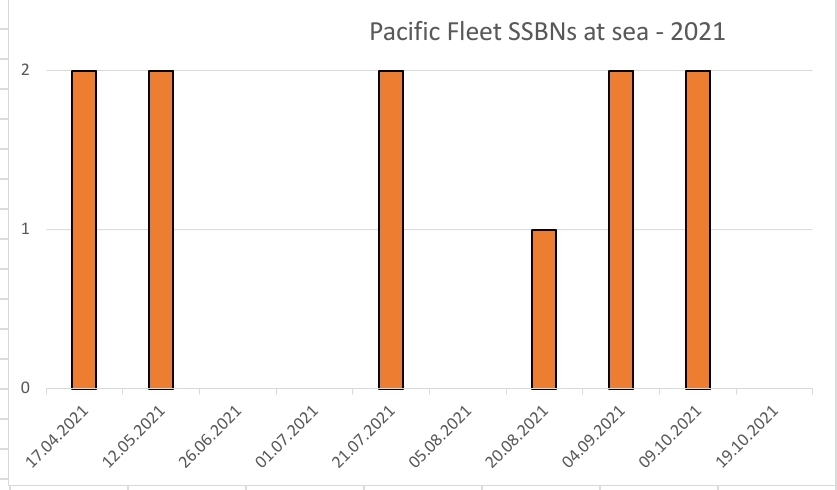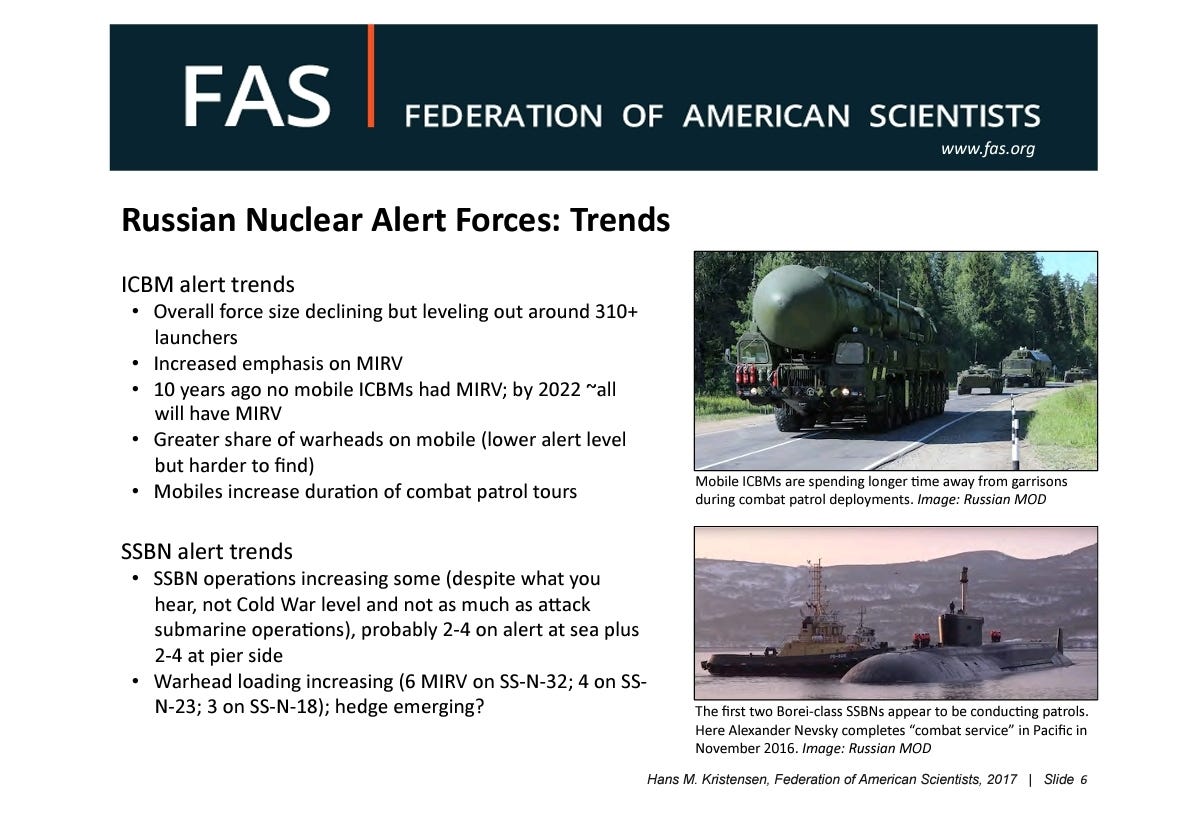Taking the pulse on the Russian SSBN fleet
Using open sources to look at the pace of Russian SSBN operations.
After completing my series on the Yasen-class SSGNs in 2022 (Part 1 and Part 2), I decided to take a more thorough look at the SSBN fleet. Those who have followed me on Twitter for a while know I try to keep track of SSBN activity, primarily the Northern Fleet with an occasional look at the Pacific, using Sentinel imagery and all the higher resolution imagery and other sources I can find.
What I tried to do here is convert that work into numbers, looking at both 2021 and 2022, to see what we can learn from that about the pace of operations of the Russian SSBN fleet.
Sources, methods, delimitations and clarifications
The primary source compiling this is Sentinel-2 imagery, which due to the low resolution has it's limitations, so errors are possible and normal Sentinel caveats apply. That said, with experience and regular comparison with higher resolution imagery, confidence is high enough to make usable estimates.
The selection of dates included in the data sets only includes dates with good weather, no sea-ice or other interference that makes analysis of the number of SSBNs alongside more difficult than usual.
I have also made the decision to only include dates where the main piers and all missile loading piers are visible on the same pass. This results in more gaps in the coverage, making each entry a snapshot, opposed to detailed tracking of every movement. Visits to other naval piers in the local area, such as the Severomorsk main piers for NORFLT SSBNs, are also excluded.
It's important to note that an SSBN at sea doesn't automatically mean on patrol. As all warships, SSBNs need to train, so they have work-up periods and participate in exercises. It is also worth having in mind that Soviet and Russian SSBNs traditionally has maintained a lower pace of operations than their Western counterparts, spending more time alongside.
Russian SSBNs are also believed to stand pier-side alert1. Back in Soviet times, a at least one pier-side SLBM live firing test was conducted, so at sea vs alongside doesn't tell the whole story about their readiness posture.
The Delta-I class SSBN K-385 conducting a pier-side SLBM live-firing of a SS-N-8/R-29 in Porchnikha bay, 1982.
I won't provide all imagery analysed in the process of compiling the data, but here is a selection of previously published analysis, which have been supplemented for additional data points.
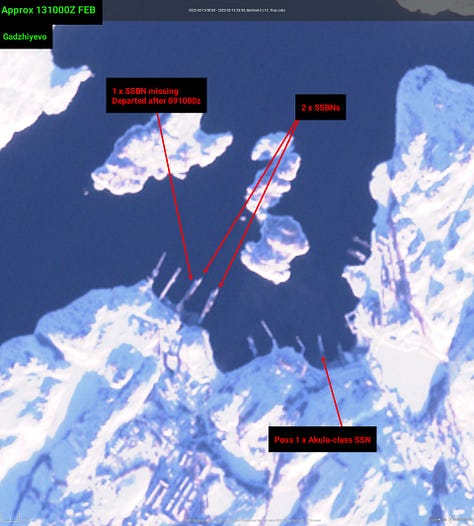

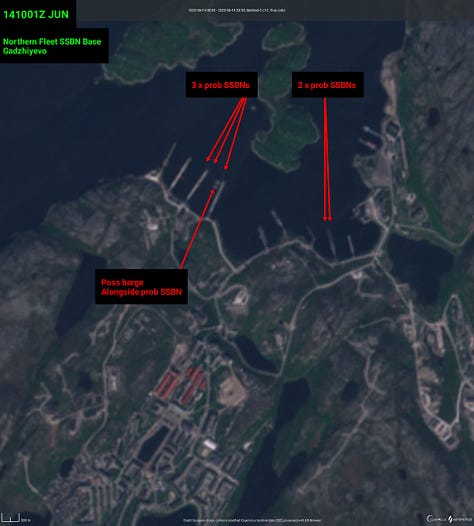
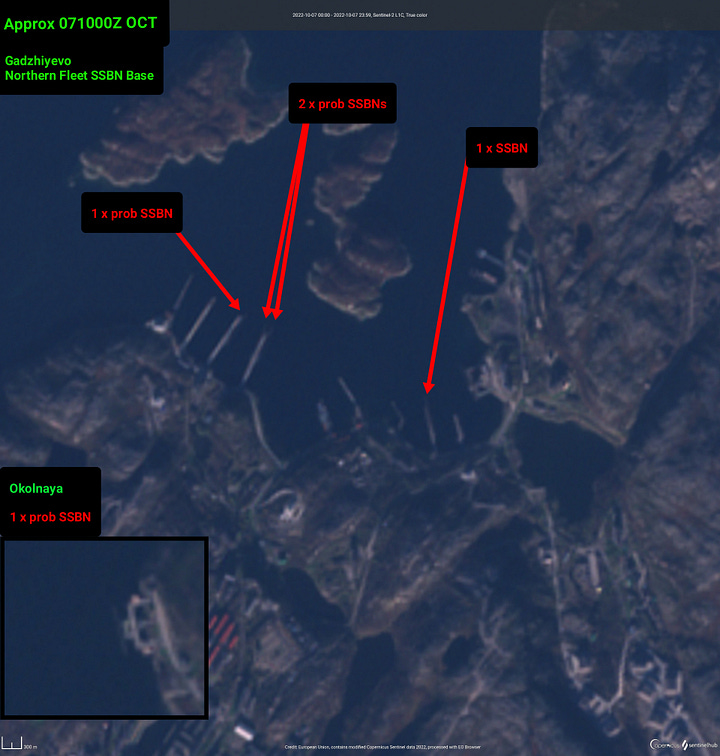
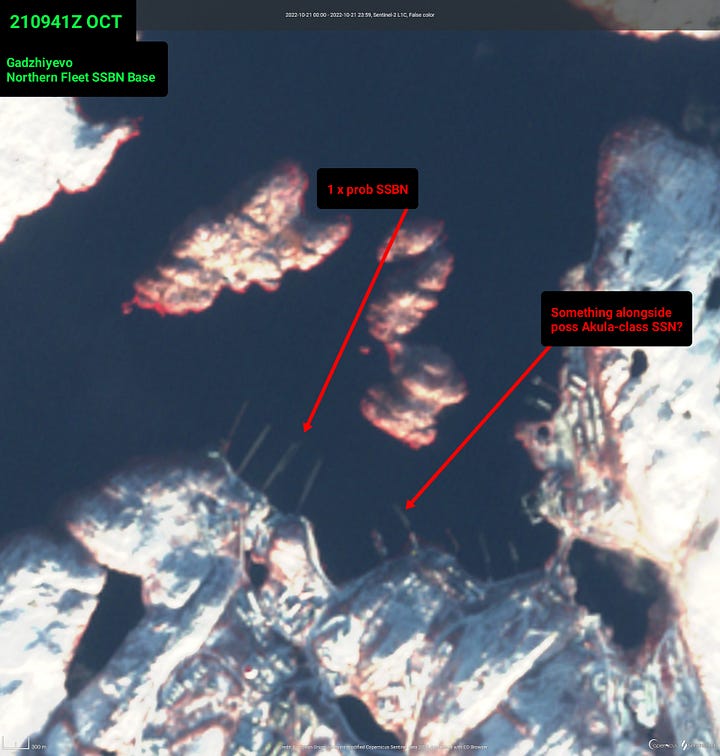
Special considerations on the Pacific Fleet data
The Vilyuchinsk Missile Piers does offer a challenge due to the low resolution of Sentinel imagery. After some deliberation, my criteria for saying than an SSBN was present there, was that the crane is seen over the pier.
This issue does mean that the confidence level on PACFLT data is lower than for NORFLT.
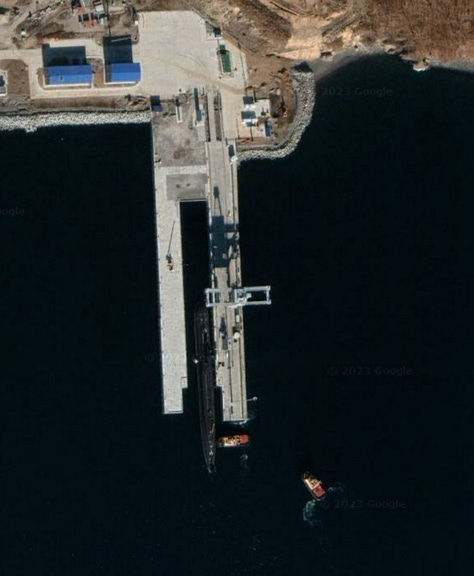
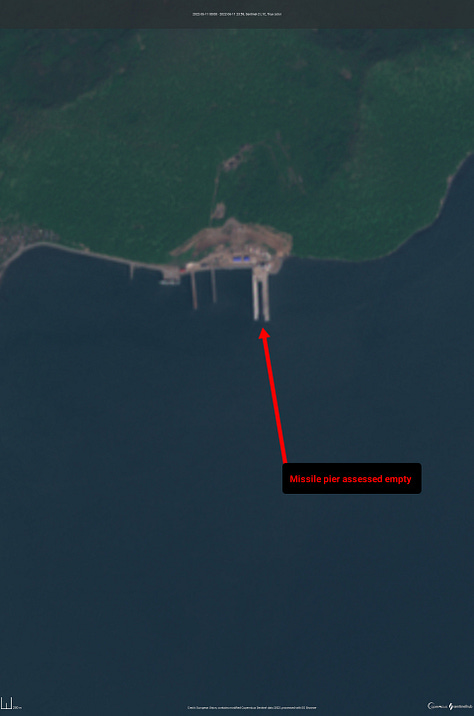
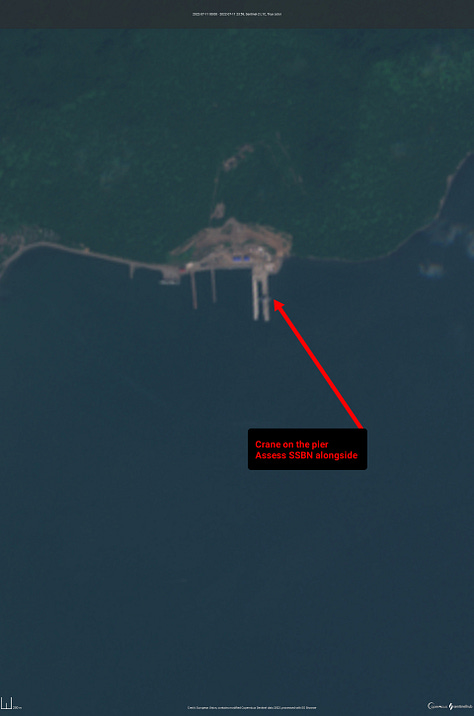
1. Google Earth reference imagery. 2: Pier assessed empty. 3: Assess SSBN alongside
Northern Fleet
For 2022, NORFLT had 6 operational SSBNs, 2 Borei's and 4 Delta-IV's. The Delta-IV Ekaterinburg deserves a special mention as it was likely decommissioned sometime within the reporting period. The Ekaterinburg is believed to still be in Gadzhiyevo, so is therefore included in the NORFLT total figure needed to make the assessment on the number at sea, both for 2022 and 2021.
The Delta IV Bryansk has been in Severodvinsk for an overhaul since 2018, which has been delayed. The Bryansk still remains there as of March 2023, and is hence excluded.
From January to August 2022, the newly commissioned PACFLT Borei-class SSBN was on Kola, preparing for the under-ice transfer, so up to and including August 17th 2022, Knyaz Oleg is included in the NORFLT count for a total of 82. The total number after that and for 2021 was 7.
Here are the graphs of NORFLT SSBNs assessed as at sea, on dates matching my selection criterias. In 2022, there are two noticeable peaks.
The first in February, with a small dip on the 23rd, coincidences with the pre-invasion strategic exercise and the period immediately after the invasion. However, most SSBNs were back alongside by March 6th, when a more normal pattern likely was resumed.
The second peak, in October, coincides with Grom-2022, the strategic nuclear forces exercise, which this year featured a fairly limited limited live-firing part compared to recent years. Looking at the correlating SSBN surge, which seems to have included all operational NORFLT SSBNs, it is likely dispersal from base was an element in the exercise for this fleet.
Keeping in mind that we are looking at snapshots, with varying intervals, the rest of the year is characterized by dates where 1 to 3 NORFLT SSBNs are assessed to be at sea.
In 2021 we don't have the very high peaks, likely due to no strategic exercises conducted that year. With between 1 - 3 SSBNs assessed as at sea on the selected dates, the level of activity 2021 does look similar to large parts of 2022.
Pacific Fleet
PACFLT started 2022 with 2 Borei-class SSBNs. From August 17th, I count the Knyaz Oleg as PACFLT, for a total of 3.
The Delta III-class Ryazan was converted to SSN sometime in 2021 and is not counted, neither in the 2022 or 2021 PACFLT data.3
Due to my selection criterias, the data-set only starts in mid to late April for the Pacific Fleet.
Relative to the total number of PACFLT SSBNs and on dates matching the selection criterias, on first glance, the pace of operations could seem higher at times than for NORFLT in 2022. When looking at these figures, it is important to bear in mind that there are large holes in the coverage, the whole year isn't covered and there is the missile-pier issue. Therefore I will not make hard conclusions on a possibe higher relative pace in the Pacific based on this data-set.
Looking at 2021 I get these numbers, with one date less in the series than for 2022. The total number counted for this year was 2 Borei's. As for 2022, the level of activity relative to the number of SSBNs seems higher than in NORFLT, but again, due to the issues mentioned for 2022, I won't make hard conclusions here either. To get a good answer to this question, more data-points are needed.
Assessment on pace of operations
If look beyond the strategic exercises of 2022, it seems likely that in total, for both fleets, between 1-5 with a median more in the 2-4 range was the norm for the total number SSBNs at sea these two years.
These numbers are also fairly in-line with this assessment by Hans M. Kristensen from 20174.
Post invasion considerations
On February 27th 2022, President Putin announced he had ordered a “special regime of combat duty5” for the strategic nuclear forces. 2022 also featured an ebb and flow of Russian nuclear rethoric and threats from various officials and pundits.
Looking at the data, and excluding the strategic exercises, it seems the invasion of Ukraine and resulting NATO - Russia tensions did not result in a long term change in SSBN patterns of activity. This conforms with repeated statements by various Western officials through the year.
An important caveat on overall SSBN force readiness is the pier-side alert. This data-set in particular, and likely open sources in general, cannot reliably determine details or changes to pier-side alert status. However, when looking at this aspect, Western statements on no concerning changes in overall nuclear forces readiness needs to be taken into account.
Autumn of 2019 and Grom 2020
For more comparison, I did check if there was imagery available for the autumn of 2019, when NORFLT conducted a large submarine operation6, in addition to the large strategic forces exercise Grom 20197, but not enough data was available.
Grom 2020 was conducted in December, meaning no optical imagery of NORFLT bases is available for this period either.
A snapshot from 2023
So far in 2023 there has been only one date matching my criterias for NORFLT bases, February 11th, where the number of SSBNs assessed as at sea was 3.
No data on PACFLT meeting the requirements, so far.
Summing up
Bearing in mind the limitations and possible errors by relying on Sentinel imagery, I do think I have managed to outline the pace of Russian SSBN activity with usable confidence.
Looking at SSBNs at sea, the level of activity has likely been pretty stable over at least the last 5-6 years. The fact that Russia in 2022 was engaged in a major conventional war that hasn't exactly gone according to their initial plans and the resulting tensions with NATO doesn't seem to have changed this.
As a final note, I also hope this article will be helpful in detecting any possible deviations from the established patterns in the future.
Regards
The Lookout
Alert Status of Nuclear Weapons, Hans M. Kristensen, April 21 2017
https://www.google.com/url?sa=t&source=web&rct=j&url=https://uploads.fas.org/2014/05/Brief2017_GWU_2s.pdf&ved=2ahUKEwihy67Pqtz9AhVlhosKHTrDAo8QFnoECCIQAQ&usg=AOvVaw2RDmW4fXlb-akjmMAZLgtZ
Knyaz Oleg arrived Vilyuchinsk September 28th 2022: https://thebarentsobserver.com/en/security/2022/09/nuclear-subs-made-trans-arctic-under-ice-transfer-barents-pacific
http://redstar.ru/garant-stabilnosti-v-aziatsko-tihookeanskom-regione/
Alert Status of Nuclear Weapons, Hans M. Kristensen, April 21 2017
https://www.google.com/url?sa=t&source=web&rct=j&url=https://uploads.fas.org/2014/05/Brief2017_GWU_2s.pdf&ved=2ahUKEwihy67Pqtz9AhVlhosKHTrDAo8QFnoECCIQAQ&usg=AOvVaw2RDmW4fXlb-akjmMAZLgtZ
https://www.rferl.org/a/putin-russia-nuclear-deterrant-forces-alert/31726441.html
https://www.nrk.no/norge/hemmelig-ubat-operasjon_-_malet-er-a-vise-at-russland-kan-na-usa_-1.14761298
https://www.realcleardefense.com/articles/2019/10/30/key_features_of_russias_grom_2019_nuclear_exercise_114822.html
